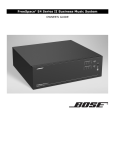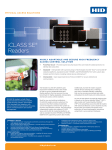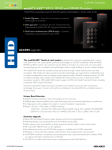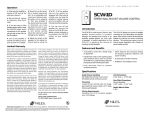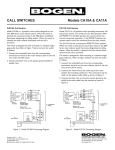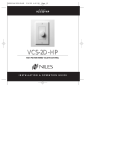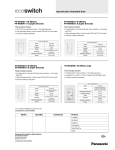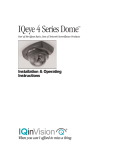Download Bose Volume Control User Interface Specifications
Transcript
FreeSpace® E-4 Business Music System OWNER’S GUIDE Contents 1.0 Introduction . . . . . . . . . . . . . . . . . . . . . . . . . . . . . . . 1.1 The Bose® FreeSpace® E-4 business music system . . . . . . . . . . . . . . . . . . . . . . . . . . 1.2 E-4 system accessories . . . . . . . . . . . . . . . . . . 1.3 FreeSpace Installer™ software . . . . . . . . . . . . . 2.0 Designing with the E-4 System . . . . . . . . . . . . . . . . 2.1 Introduction . . . . . . . . . . . . . . . . . . . . . . . . . . . . 2.2 Basic design steps . . . . . . . . . . . . . . . . . . . . . . 2.2.1 Step 1 – Determine source routing . . . . . . 2.2.2 Step 2 – Determine Auto Volume requirements . . . . . . . . . . . . . . . . . . . . 2.2.3 Step 3 – Determine volume control requirements . . . . . . . . . . . . . . . . . . . . 2.2.4 Step 4 – Determine the speaker requirements . . . . . . . . . . . . . . . . . . . . 2.2.5 Step 5 – Determine the E-4 requirements . . . . . . . . . . . . . . . . . . . . 2.3 Auto Volume layout examples . . . . . . . . . . . . . 3.0 E-4 Hardware Description . . . . . . . . . . . . . . . . . . . . 3.1 Front panel . . . . . . . . . . . . . . . . . . . . . . . . . . . . 3.1.1 Controls . . . . . . . . . . . . . . . . . . . . . . . . . . 3.1.2 Indicators . . . . . . . . . . . . . . . . . . . . . . . . . 3.2 Rear panel . . . . . . . . . . . . . . . . . . . . . . . . . . . . . 3.2.1 System controls . . . . . . . . . . . . . . . . . . . . 3.2.2 Audio source inputs . . . . . . . . . . . . . . . . . 3.2.3 Amplifier outputs . . . . . . . . . . . . . . . . . . . 3.2.4 AC power . . . . . . . . . . . . . . . . . . . . . . . . . 4.0 Hardware Installation . . . . . . . . . . . . . . . . . . . . . . . . 4.1 Introduction . . . . . . . . . . . . . . . . . . . . . . . . . . . . 4.2 Included accessories . . . . . . . . . . . . . . . . . . . . 4.3 Placement guidelines . . . . . . . . . . . . . . . . . . . . 4.4 Shelf mounting the E-4 unit . . . . . . . . . . . . . . . 4.5 Rack mounting the E-4 unit . . . . . . . . . . . . . . . 4.6 Installing accessories . . . . . . . . . . . . . . . . . . . . 4.6.1 Sensing microphones . . . . . . . . . . . . . . . . 4.6.2 User interfaces . . . . . . . . . . . . . . . . . . . . . 4.7 System wiring . . . . . . . . . . . . . . . . . . . . . . . . . . 4.7.1 Auto volume microphone inputs . . . . . . . 4.7.2 Serial data communications . . . . . . . . . . . 4.7.3 User interface connections . . . . . . . . . . . 4.7.4 Remote standby switch . . . . . . . . . . . . . . 4.7.5 LINE 1/LINE 2 source input . . . . . . . . . . . 4.7.6 AUX MIC/LINE 3 source input . . . . . . . . . 4.7.7 PAGE/MIC/LINE 4 source input . . . . . . . . 4.7.8 DIRECT IN/CONTROL source input . . . . . 4.7.9 Amplifier ZONE OUT outputs . . . . . . . . . . 4.7.10 Output voltage setting (70/100V) . . . . . . 4.7.11 ZONE 4 LINE OUT output . . . . . . . . . . . 4.8 AC power connections . . . . . . . . . . . . . . . . . . . 13 13 13 14 15 15 15 15 15 18 18 19 20 23 23 23 23 24 24 24 24 24 25 25 25 25 25 26 27 27 27 29 29 29 29 29 30 30 31 31 32 32 33 33 5.0 Using FreeSpace® System Installer™ Software . . . 5.1 Installing the software . . . . . . . . . . . . . . . . . . . . 5.2 Connecting to the E-4 system . . . . . . . . . . . . . 5.2.1 Connecting to another hardware device . . . . . . . . . . . . . . . . . 5.2.2 Viewing the sample design file . . . . . . . . 5.3 The Installer™ software user interface . . . . . . . 5.4 Set Up Hardware mode . . . . . . . . . . . . . . . . . . 5.5 Set Up Schedule mode . . . . . . . . . . . . . . . . . . 5.5.1 Setting the clock . . . . . . . . . . . . . . . . . . . 5.5.2 Adding events . . . . . . . . . . . . . . . . . . . . . 5.5.3 Viewing and changing event settings . . . 5.5.4 Removing events from the list . . . . . . . . . 5.6 Service Hardware mode . . . . . . . . . . . . . . . . . . 6.0 E-4 System Setup . . . . . . . . . . . . . . . . . . . . . . . . . . 6.1 Introduction . . . . . . . . . . . . . . . . . . . . . . . . . . . 6.2 Connecting your PC to an E-4 system . . . . . . . 6.3 System setup procedure . . . . . . . . . . . . . . . . . 6.3.1 Output gain . . . . . . . . . . . . . . . . . . . . . . . 6.3.2 Zone setup . . . . . . . . . . . . . . . . . . . . . . . . 6.3.3 Input gain . . . . . . . . . . . . . . . . . . . . . . . . . 6.3.4 Source assign . . . . . . . . . . . . . . . . . . . . . 6.3.5 Source EQ . . . . . . . . . . . . . . . . . . . . . . . . 6.3.6 Page set up . . . . . . . . . . . . . . . . . . . . . . . 6.3.7 Zone EQ . . . . . . . . . . . . . . . . . . . . . . . . . . 6.3.8 Dynamic EQ . . . . . . . . . . . . . . . . . . . . . . . 6.3.9 Auto Volume . . . . . . . . . . . . . . . . . . . . . . 7.0 User Interface Operation . . . . . . . . . . . . . . . . . . . . 7.1 Introduction . . . . . . . . . . . . . . . . . . . . . . . . . . . 7.2 Standard user interface operation . . . . . . . . . . 7.3 Auto Volume interface operation . . . . . . . . . . . 8.0 E-4 System Troubleshooting . . . . . . . . . . . . . . . . . 8.1 Introduction . . . . . . . . . . . . . . . . . . . . . . . . . . . 8.2 E-4 hardware indicators . . . . . . . . . . . . . . . . . . 8.2.1 Normal operation . . . . . . . . . . . . . . . . . . . 8.2.2 System fault . . . . . . . . . . . . . . . . . . . . . . . 8.2.3 Amplifier fault . . . . . . . . . . . . . . . . . . . . . . 8.2.4 Input clipping . . . . . . . . . . . . . . . . . . . . . . 8.2.5 Direct input is active . . . . . . . . . . . . . . . . 8.2.6 No STANDBY and SYSTEM indicators . . 8.3 FreeSpace® E-4 system Error Log . . . . . . . . . . 8.3.1 Contents of the Error Log . . . . . . . . . . . . 8.3.2 Hardware configuration . . . . . . . . . . . . . . 8.3.3 Power-on self-test results . . . . . . . . . . . . 8.3.4 Amplifier alarms . . . . . . . . . . . . . . . . . . . . 8.3.5 Solving faults reported in the Error Log . . 11 of 76 34 34 34 36 36 37 39 40 41 41 42 42 43 45 45 45 46 46 47 48 50 51 52 53 54 54 60 60 60 60 61 61 61 61 61 62 63 63 63 64 64 64 64 65 66 Contents 8.4 Common problems . . . . . . . . . . . . . . . . . . . . . . 8.4.1 Communications port error . . . . . . . . . . . 8.4.2 No audio in zone . . . . . . . . . . . . . . . . . . . 8.4.3 User interface keypads do not operate correctly . . . . . . . . . . . . . . . . . 8.4.4 Bad sound in a zone . . . . . . . . . . . . . . . . . 8.4.5 User interface selects unassigned sources . . . . . . . . . . . . . . 8.4.6 Auto Volume does not calibrate . . . . . . . . 8.4.7 All front panel LEDs are amber . . . . . . . . . 8.5 Customer support . . . . . . . . . . . . . . . . . . . . . . . 8.5.1 Technical assistance . . . . . . . . . . . . . . . . 8.5.2 Reporting software bugs and issues . . . . 9.0 Upgrading E-4 Microcontroller Code . . . . . . . . . . . 10.0 Technical Specifications . . . . . . . . . . . . . . . . . . . . 10.1 Power amplifier . . . . . . . . . . . . . . . . . . . . . . . . 10.2 Digital signal processing . . . . . . . . . . . . . . . . . 10.3 Front panel indicators and control connections . . . . . . . . . . . . . . . . . . . . . 10.4 Rear panel inputs, outputs, and controls . . . . 10.5 E-4 system serial data commands . . . . . . . . . 67 67 67 68 68 69 69 69 69 69 70 71 73 73 73 73 73 74 12 of 76 1.0 Introduction 1.1 The Bose® FreeSpace® E-4 business music system • Opti-Voice® Paging: Provides the appropriate sound level regardless of variations in speech projection • Source Leveling: Automatically compensates for variations in source input levels • Dynamic Equalization: Maintains tonal balance at all listening levels • Room Equalization: Provides easy adjustment of tonal balance in each zone • Signal Routing: Meets the demands of most four-zone systems, allowing for an input source to be routed to any of the four amplifier outputs • Serial Data Interface: RS-232 serial port for easy interfacing to your PC • Contact Closure Input: Accepts a remote STANDBY switch The Bose FreeSpace E-4 system is an integrated four-channel digital signal processor and 400-watt power amplifier for 70/100V business music applications. The E-4 system has a total of four source inputs, including two Line In, one Mic/Line and one Mic/Page/Line, to provide the inputs needed for most business music installations. The system also has a direct input which can override the sources playing on all four output channels. The E-4 system has four amplifier output channels which can be configured for different zones. A Music on Hold output is also provided for simple integration into a phone system. The integrated 400-watt power amplifier features a patented power-sharing technology which dynamically allocates power to each output. For example, if you have a two-zone system that requires 5 watts in Zone 1 and 395 watts in Zone 2, the FreeSpace E-4 system electronics distributes the power based on those needs. The E-4 also includes an easy-to-replace memory module, which holds the system configuration settings and design file uploaded by the FreeSpace Installer™ software (see page 14). 1.2 E-4 system accessories Optional Bose accessories for the E-4 system are available. In a single chassis, it provides all of the processing and control features required for one-to-four zone business music applications. These features include: • Auto Volume: When used with the optional FreeSpace system Auto Volume Sense Mic, E-4 system electronics dynamically control the program level in each zone so your customers can always hear it, regardless of the background noise • Scheduling: Allows you to program the E-4 system electronics for automated on/off control, source changes, and volume changes according to time of day or day of week • FreeSpace E-4 System User Interface Kit (U.S.) (PC029856) A wall-mountable keypad that fits into a standard U.S. singlegang junction box. It provides buttons for volume up/down control, 1-3 source selection, and mute. • FreeSpace E-4 System User Interface Kit (Euro) (PC029857) A wall-mountable keypad that fits into a standard Euro singlegang junction box. It provides buttons for volume up/down control, 1-3 source selection, and mute. 13 of 76 1.0 Introduction • FreeSpace® E-4 System Auto Volume Interface Kit (U.S.) (PC030101) A wall-mountable keypad that fits into a standard U.S. singlegang junction box. It provides buttons for volume up/down control, 1-3 source selection, and Auto Volume on/off. 1.3 FreeSpace Installer™ software • FreeSpace E-4 System Auto Volume Interface Kit (Euro) (PC030102) A wall-mountable keypad that fits into a standard Euro singlegang junction box. It provides buttons for volume up/down control, 1-3 source selection, and Auto Volume on/off. • FreeSpace E-4 System Auto Volume Mic Kit (U.S.) (PC029859) One sensing microphone that can be mounted as is or in a standard U.S. single-gang junction box. • FreeSpace E-4 System Auto Volume Mic Kit (Euro) (PC029860) One sensing microphone that can be mounted as is or in a standard Euro single-gang junction box. • FreeSpace E-4 System Accessory Kit (U.S.) (PC030105) Supplemental rear panel mating connectors and non-skid feet. • FreeSpace E-4 System Rack Mount Kit (PC029858) One pair of rack ears. Bose® FreeSpace Installer software is included with every E-4 system. The Installer software allows you to configure hardware devices such as the E-4 system. The Installer software is designed for use on a PC that is connected to the E-4 system through a serial data interface. The Installer software requires a computer system with the following minimum requirements: • 400 MHz Pentium®-based PC • 256 MB of RAM • 50 MB of available hard-drive space • RS-232 serial port • 800 x 600 display • 4x CD-ROM drive • Microsoft Windows® 98, Windows® 98SE, Windows® NT, Windows® 2000 14 of 76 2.0 Designing with the E-4 System 2.1 Introduction Guidelines for establishing Auto Volume zones This section describes the basic steps for designing an E-4 system and includes an example. It is assumed that a complete loudspeaker design and layout has already been created. Speaker height is… >25 ft (7.6 m) 2.2 Basic design steps There are five basic steps in designing an E-4 system. 2.2.1 Step 1 – Determine source routing Area 1 ● Area 2 ● Area 3 ● Area 4 ● Area 5 ● Source 2 Source 3 Not recommended One Auto Volume zone for every 3600 ft2 (324 m2) One Auto Volume zone for every 1800 ft2 (162 m2) <12 ft (3.7 m) One Auto Volume zone for every 1800 ft2 (162 m2) One Auto Volume zone for every 900 ft2 (81 m2) Speaker mounting height and the overall quality of the background noise is used to determine the Auto Volume zoning requirements. Uniform background noise is found in an area where no part of the area is louder or quieter than any other. A room with non-uniform background noise would seem louder in some areas (people talking, machinery running, etc.) and quieter in others. Source 4 ● ● Background noise is non-uniform 12-25 ft (3.7-7.6 m) Decide which sources will be played in each area. Create a “source map” such as the following one that shows which sources will be played in each major area of the facility. Source 1 Background noise is uniform ● ● Mounting guidelines for sensing microphones • The sensing microphone must be mounted at the same height as the loudspeakers or higher. A sensing microphone must never be mounted lower than the speaker height. • In all cases, there must be 6 ft (1.8 m), minimum, between the loudspeaker and the sensing microphone. This is so that the microphone does not receive signals only from a loudspeaker. 2.2.2 Step 2 – Determine Auto Volume requirements • There must be 35 ft (10.7 m), minimum, between the sensing microphones of two adjacent Auto Volume zones. Identify which areas will use Auto Volume. Each Auto Volume zone must use one Auto Volume user interface and one Bose® sensing microphone to control the volume. A 70/100V volume control cannot be used. • Avoid placing the microphone near unique noise sources like HVAC equipment, dishwashers, motors, etc. When using Auto Volume, remember that you will be adjusting the volume of an overall area. Imagine that you have a dining area and a bar adjacent to one another. If the sensing microphone is placed above the bar, the music may become too loud in the dining area. Likewise, if you place the sensing microphone above the dining area, the music may never be heard in the bar. Separating the microphones as much as possible for two zones is the best practice. Consider the previous example of the dining area and a bar adjacent to one another. If each of these areas uses Auto Volume, it is possible to create a situation in the dining area where the music is too loud simply because the microphone is too close to the bar. 15 of 76 2.0 Designing with the E-4 System The following are examples of correct and incorrect sensing microphone placements: Ceiling Flush Correct placement Incorrect placement Sensing microphone Sensing microphone Wall Surface Correct placement Incorrect placement Sensing microphone Sensing microphone Mic 16 of 76 2.0 Designing with the E-4 System When mounting sensing microphones, always maintain a distance of 6 feet (1.8 m) minimum between the microphone and the speaker. Wall Surface Ceiling Flush Sensing microphone ≥6 ≥ ft6' (1.8 m) ≥6 ft (1.8 m) Mic ≥6 ft (1.8 m) Sensing microphone Ceiling Surface ≥6 ft (1.8 m) Mic ≥6 ft ≥ m) 6' (1.8 17 of 76 ≥ 6' Sensing microphone ≥6 ft (1.8 m) ≥ 6' 2.0 Designing with the E-4 System 2.2.3 Step 3 – Determine volume control requirements 2.2.4 Step 4 – Determine the speaker requirements Decide which areas will have volume controls. Create a control map, such as the following, showing the types of controls that will be used, and the areas in which they will be installed. Determine the speaker coverage required for the design. Consider the following points as you do this: Auto Volume Interface 1 Area 1 Auto Volume Interface 2 70/100V Volume Control 1 70/100V Volume Control 2 • Each type of actively equalized speaker requires the dedicated use of one E-4 output channel. If you are designing a system that uses actively equalized speakers, such as the 102®F speaker, Model 32, Model 32SE, or Model 8, you must dedicate one E-4 output channel for each speaker type. If you have a system that uses passive speakers, such as the FreeSpace 3® system, Model 16 or 302™A speaker, you can mix and match them on an E-4 output channel. ● ● Area 2 Area 3 • Each Auto Volume function requires a separate zone. Each Auto Volume zone requires the dedicated use of one E-4 output channel. ● Area 4 ● Area 5 ● Create a speaker map, such as the following, and match the speaker models to areas (Speaker Qty x Tap = Zone Power required): Standard and Auto Volume interfaces are available for use with the E-4 hardware. Each offers control over source selection and volume. The Standard interface contains a Mute button, and the Auto Volume interface contains an Auto Volume on/off button. If you have identified an area that uses Auto Volume, you must use an Auto Volume interface to control this zone. It is also possible to use 70/100V volume controls between the amplifier output and the speaker input. If you plan to use 70/100V controls, be aware that they cannot be used in zones where either Auto Volume or Dynamic EQ is used. Auto Volume and Dynamic EQ monitor the amplifier output and make adjustments accordingly. Using a 70/100V volume control would cause these functions to operate improperly. Model 32SE Area 1 Area 2 FreeSpace 3-I Speaker Qty Tap Area Power ● 2 50 100 5 8 40 1 50 50 ● ● Area 3 Area 4 ● 3 4 12 Area 5 ● 6 8 48 When determining the placement or physical location of the controls, first think about how the control is used. If the control is very rarely used or it requires a secure location, it should be placed with the equipment. If the control is for an area that requires frequent adjustments, then it is best to place the control in the area being controlled. 18 of 76 2.0 Designing with the E-4 System 2.2.5 Step 5 – Determine the E-4 requirements Now we can take a look at how the maps we created can help us determine the quantity of E-4s we will need. Once you have identified the areas that use Auto Volume and unique loudspeakers, you can combine different areas based on the types of sources and controls they are using. Sources 1 2 3 Controls 4 ● AV1 AV2 VC1 Loudspeakers VC2 M32SE Total W E-4 Ch. ● 100 1 40 2 50 3 Area 1 ● Area 2 ● Area 3 ● Area 4 ● ● ● 12 4 Area 5 ● ● ● 48 4 ● ● FS3 ● ● ● ● ● ● Total System Power = 250W By combining the maps you can easily combine sources, speaker types, and control types. The information placed in this table suggests that Area 1 and Area 3 need to be grouped separately because they are Auto Volume zones requiring separate E-4 system outputs. Area 2 uses one standard volume control requiring one E-4 output channel. Areas 4 and 5 share a common volume control and can be combined on a third E-4 output channel. Since only four outputs are required and the total combined power requirement is less than 400W, only one E-4 unit would be needed for this system. 19 of 76 2.0 Designing with the E-4 System 2.3 Auto Volume layout examples Large, open retail space with single music source FreeSpace® Acoustimass module Model 16 (pendant mounted) Sensing microphone 20 of 76 2.0 Designing with the E-4 System Hair salon (Small space with specific noise) FreeSpace® 3 system Sensing microphone 21 of 76 2.0 Designing with the E-4 System Hotel lobby 22 ft (6.7 m) 40 ft (12.2 m) Model 16 (flush mounted) Sensing microphone 22 of 76 76 ©2003 Bose Corporation, The Mountain, Framingham, MA 01701-9168 USA 268134 AM Rev.01 JN31022














